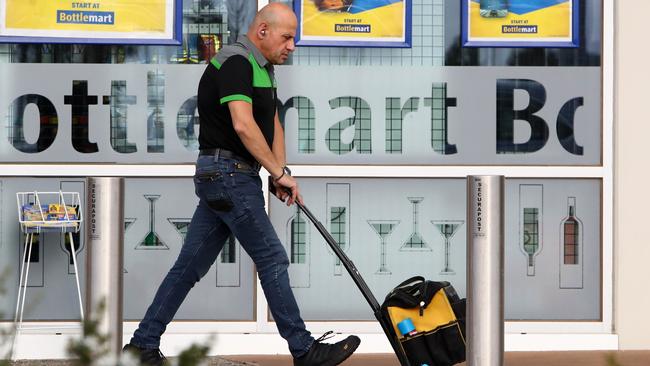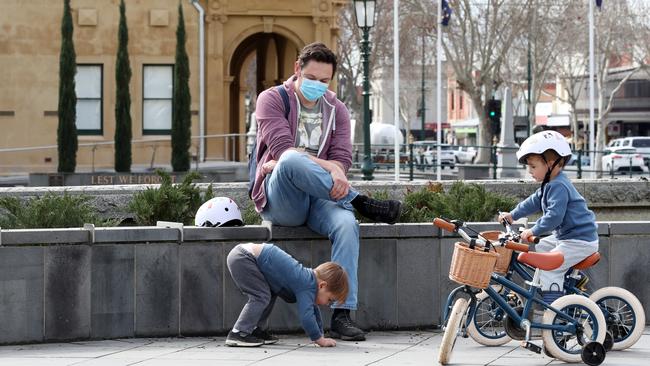Melbourne postcodes point to coronavirus pain
Australia has been spared the social divisions that have afflicted many cities, but COVID is set to change that.

In comparison, Melbourne’s flat chequerboard of streets and roads is more easily traversed, which could more easily lead to the spread of contagion, was my central argument. And while this logic may or may not be correct there is another factor to be considered in managing the coronavirus risk in Melbourne and in parts of Sydney, Brisbane, Perth and Adelaide.
Many of Melbourne’s outbreaks were identified as surfacing in suburban workplaces such as meatworks, warehouses and aged-care homes. Let’s consider the link between coronavirus cases and the demographic characteristics of the workforce by postcode.
In late June, the Australian Bureau of Statistics published estimates of the labour force for May 20 updating previous estimates relating to February 20. Across this three-month coronavirus-affected period the Australian workforce contracted by 822,000 jobs or 6 per cent.
Every occupation is classified by the ABS as falling into one of five skill categories ranging from the most skilled Skill Level 1 (for example, doctor, engineer) to the least skilled skill level 5 (for example, cafe worker, sales assistant). Generally skill level 5 jobs are held by the young, by those with little or no formal training and often by immigrant workers.
Net job losses across the February-May period ranged from -16,000 in the skill level 1 category (and which rounds to a net loss of zero per cent) to -317,000 in the skill level 5 category (and which rounds to a net loss of 15 per cent).
The biggest job losses (before Melbourne’s second wave) were among occupations like sales assistant (down 94,000), kitchen hand (down 35,000), packer (down 20,000) and cafe worker (down 12,000).
Victoria’s Department of Health and Human Services publishes coronavirus case numbers by postcode. On August 13, the leading concentrations were 974 (ever, as opposed to current) confirmed cases in postcode 3029 Truganina, 741 cases in postcode 3064 Craigieburn, and 538 cases in postcode 3030 Werribee. Other notable hotspots include postcode 3020 Sunshine with 376 cases, postcode 3175 Dandenong with 222 cases, and postcode 3047 Broadmeadows with 185 cases.
There are of course many more cases in other postcodes. However, it does appear that Melbourne’s cases are clustering in the city’s outer southwest, west, north and southeast regions.
Four years ago at the census a question was asked about working from home. The question was framed so as to capture workers whose regular arrangement was to work from home rather than workers who occasionally worked from home.
When the responses to this question are set out in a chart by single year of age and skill level, an important relationship is made clear. The option of working from home increases with skill level.
Indeed, skill level 5 workers are least likely to work from home whereas skill level 1 workers (knowledge workers) clearly have the greatest scope to work from home. Indeed, before the lockdown, the worker most likely to work from home was a 45-year-old knowledge worker.
And so, with the coming of the coronavirus, a good proportion of Australia’s 4.3 million skill level 1 workers simply decamped from their city offices and relocated to their home offices.
And by May, according to the ABS, not even a single rounded-up one percentage point of this workforce had lost their jobs (in net terms). It may be concluded that the brunt of the shutdowns (to May) has been mostly borne by low-skilled workers.
So, which postcodes across Melbourne and other capital cities have the greatest proportion of workers in the most vulnerable skill level 5 job category?
Whereas at a national level 15 per cent of jobs fell within the skill level 5 category on May 20, this proportion was 21 per cent of the workforce based in postcode 3064 Craigieburn, 19 per cent for postcode 3029 Truganina, and 16 per cent for postcode 3030 Werribee. Other coronavirus hotspots include postcode 3021 St Albans, where skill level 5 workers comprise 29 per cent of the workforce; and postcodes 3020 Sunshine, 3047 Broadmeadows and 3175 Dandenong, where low-skilled workers collectively comprise no less than 26 per cent of the workforce in each location.
In other words, coronavirus cases are associated with postcodes dominated by low-skilled workers who are less likely to work from home. Indeed, the nature of many skill level 5 jobs is that they comprise casual employment and gig economy jobs and often involve tasks requiring close collaboration with other workers (for example, meatworks) and members of the public (for example, shop assistants, taxi drivers).
There is not a perfect correlation between skill level 5 workers as measured by the 2016 census and DHHS coronavirus case numbers on August 10 but the association is close enough to suggest a meaningful connection. And especially when considered in the context of low case numbers in Melbourne’s inner-eastern knowledge-worker belt.
We have mapped all major cities (as well as Australia) on the basis of skill level 5 workforce concentrations at the last census (see online mapping).
Sydney and other cities have the advantage of being forewarned (by the Melbourne experience) as to where and how the coronavirus spreads. In demographic terms, the city’s west and southwest is remarkably similar to Melbourne west and north.
Postcodes with a large proportion of the workforce comprised of skill level 5 workers include, for example, Sydney’s 2165 Fairfield (25 per cent), Brisbane’s 4114 Logan (30 per cent), Adelaide’s 5094 Gepps Cross (28 per cent), and Perth’s 6064 Girrawheen (25 per cent).
A picture emerges of cities divided by skills and the capacity to work from home. This social division is especially evident in the skills mapping for Melbourne and Sydney. The notion that “we’re all in this together” is indeed a noble ideal but the evidence of job losses (mostly skill level 5), and of access to work from home (mostly skill level 1), tells a different story.
Should the lockdowns continue, should the support payments be withdrawn, should job opportunities shift in the recovery phase away from skill level 5 “battlers”, then there is scope for disaffection on a grand scale.
And especially if the perception is that a large chunk of the workforce — so-called privileged knowledge workers — have come through the COVID experience relatively unscathed. Australia has been largely free of the kind of social divisions that have afflicted many US, French and British cities in recent years. I have always put that down to our easygoing nature and the work and lifestyle opportunities on offer in our young and growing nation.

But the post-COVID world, if poorly managed, could usher in a vastly different Australia racked by social division based on access to secure, meaningful and rewarding work in sufficient measure to support a family, a lifestyle and maybe the opportunity of home ownership.
The discussion we should be having now isn’t so much how do we recover from the pandemic but what kind of a nation do we want to rebuild and bequeath to future generations.
Bernard Salt is managing director of The Demographics Group; research by Hari Hara Priya Kannan.






Several weeks ago in these pages I made the case that Melbourne’s seamless expanse of suburbia made that city more vulnerable to the spread of contagion than Sydney, where movement is constricted by the harbour and the city’s topography.